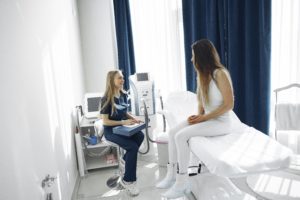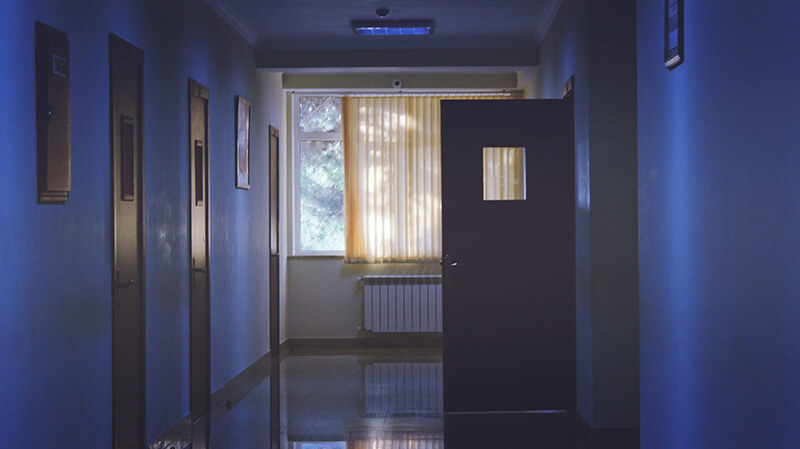Early last March, Elif Yakut, a 29-year-old medical graduate from Turkey, traveled to Philadelphia to complete her United States Medical Licensing Examination (USMLE) Step 2 Clinical Skills assessment.
After an hour of being taught the exam’s protocols, she started around 9am. Yakut saw 12 patient-actors, responding to their ‘symptoms’ and assessing ‘medical histories.’
Following each patient-actor, Yakut was given 15 minutes to write down patient notes and list potential diagnoses or tests. She says it lasted around six hours.
Yakut, a graduate of Ankara’s Yildirim Beyazit University School of Medicine, passed the exam. Currently working in a New York City pathology lab, she’s riding the Match Day rollercoaster these days, hoping to eventually practice as a pathologist.
She is also one of the very last to complete the USMLE Step 2 CS exam; an expensive, controversial necessity that has dogged American medical education for a generation.
A week after Yakut took the exam, the opening days of the COVID-19 pandemic forced its initial suspension. Its eventual demise was announced by the USMLE.
I was honestly shocked. This was the first time that I’m aware, for decades, that the USMLE has publicly said anything other than complete commitment to the clinical skills exam for licensure.
Met with genuine surprise by many, its axing has been described as a big win for med students, especially international graduates like Yakut, eager to become an American doctor at a time when the U.S. faces an increasingly large physician shortage.
Though providing a potential new source of consternation for med schools and residency programs, and cottage industry of businesses that grew up around it, the loss of the Step 2 CS exam may eventually serve as a yardstick to measure the lack of progress in other areas of standardized clinical testing.
Its eventual replacement—or not—could even give us a small tip-off to the direction American medical education is heading, post-pandemic.
“I believe it [was] like acting,” Yakut says, of the former exam. “So it’s not really beneficial for later on, in my professional life. It [felt like] just an exam I had to tick off. But was it beneficial? Not really.
“I’m happy for the students that don’t have to take this exam, but let’s see what else they will put instead of this exam – I wonder.”
A seemingly unmovable fixture
Like many things, the Step 2 CS exam was a seemingly unmovable fixture in the process of becoming a practicing doctor, pre-COVD-19. Yet as the novel coronavirus began to move across the U.S—chased throughout by the federal government’s costly, divisive response—changes snapped quickly into place.
Most classes went virtual, with third and fourth year students only allowed back for hands-on clinical training in August. Most of the first semester last year was spent away from campus for first and second years.
From March 16, 2020, the National Board of Medical Examiners (NBME) announced Step 2 CS exams would be “temporarily” suspended at its testing centers in Los Angeles, Houston, Chicago, Atlanta, and Philadelphia. Initially, the NBME hoped to resume the exam within a month.

But with ramifications of an uncontrolled pandemic becoming obvious, the NBME was forced to formally suspend the exam on May 26, 2020, for up to 18 months.
“This is something that needed to happen a long time ago – everyone knows it wasn’t right,” Dr. Dustyn Williams, founder and lead educator at OnlineMedEd, says.
“I think it’s definitely beneficial for medical students, especially the ones that had a lot of uncertainty about when to take it or how to take it – and were riding in [that] area of uncertainty,” Anastasiya Haponuk, a fourth-year med student at the University of New Mexico School of Medicine, says.
A staunch critic of the Step 2 CS exam, Dr. Bryan Carmody, a pediatric nephrologist at the Children’s Hospital of The King’s Daughters in Norfolk, Virginia, viewed its cancellation as somewhat a bombshell.
For over a year, Carmody, also a teacher at Eastern Virginia Medical School in Norfolk, has provided an in-depth spotlight on the Step 2 CS’s history and continuing issues on his blog, The Sheriff of Sodium. Pre-cancellation, he believed widespread support from state medical boards for the exam would ensure its return.
“I was honestly shocked,” Carmody says. “This was the first time that I’m aware, for decades, that the USMLE has publicly said anything other than complete commitment to the clinical skills exam for licensure.”
Though the Step 2 CS became mandatory for all American, Canadian, and international med students in the U.S. in 2004, the presence of standardized clinical skills assessments have existed since the formation of the NBME in the early 1910s.
“Their first exam was essentially a clinical skills exam, because that’s naturally how you think of evaluating a physician,” Carmody says.
Birth of a monster
The evolution of the Step 2 CS itself began in the late 1970s, when the Educational Commission for Foreign Medical Graduates (ECFMG) began receiving complaints from residency program directors that some aspiring international doctors “barely knew how to interview a patient or conduct anything more than a rudimentary physical examination.”
Pilot studies were undertaken throughout the 1980s, leading the ECFMG to develop the Clinical Skills Assessment (CSA), which was first taken by all non-Canadian foreign medical graduates in 1998. Able to be taken at more than 50 med schools, the CSA cost around $200 and lasted around half a day.
Carmody’s research showed that nearly 97 percent of international medical graduates passed the exam in its first two years, -while the amount of aspiring foreign-educated med students heading to the U.S. dropped noticeably.
Despite its popularity with residency programs, the CSA created new problems, particularly with U.S citizens who had studied internationally. The NBME’s involvement was prompted.
I believe it [was] like acting. So it’s not really beneficial for later on, in my professional life. It [felt like] just an exam I had to tick off. But was it beneficial? Not really.
By 2001, it was decided that the exam would become mandatory for all those hoping to practice in the U.S. Known as the Step 2 CS, the new NBME-ECFMG partnered exam would begin in 2004, cost $1000 and take place at one of only five testing centers across the U.S. Initial plans to administer it at med schools themselves were quietly scrapped.
Criticism of the Step 2 CS has simmered for years, with the American Medical Association (AMA) opposing it from the early 2000s. The Association of American Medical Colleges (AAMC) also expressed early concern over the financial burden placed on students by this national exam.
Before it was scrapped, the cost of the Step 2 CS had risen to $1600. Yakut estimates she spent well over $2000 on the exam last March, including flights to and from Philadelphia, and accommodation.
Those costs have been typical for virtually all med students over recent years, at a time when American student loan debt averages more than $240,000.
#EndStep2CS
In 2016, a group of Harvard Medical School students started a #EndStep2CS movement that inspired a 17,000-strong anti-exam petition, and an op-ed in the Los Angeles Times.
“For anyone who wants to end waste in medical education, getting rid of Step 2 CS is a good place to start,” Christopher R. Henderson and Nathaniel P. Morris wrote in the Times.
Their advocacy efforts seemed to backfire, with the ECFMG deciding to increase minimum passing standards in 2017. According to Carmody, the number of international attempters passing on their first attempt dropped seven percent in the following year.

The USMLE’s most recent Step 2 CS exam data shows that, in 2019, 95 percent of all American and Canadian students who took the exam in 2018-2019 passed it, with 86 percent of ‘repeaters’ passing the second time around. 77 percent of international medical graduates passed the test the first time around, along with 66 percent on their second shot.
More than any other group, international graduates are the most impacted by this week’s news. An Occupation English Test (OET) will now be required, while, since the Step 2 CS’s suspension last year, the ECFMG created six different pathways for foreign graduates to complete, for future residency spots.
The ECFMG says around 5000 international medical graduates will enter residency this year having completed one of these, instead of the Step 2 CS.
The exam cancellation fallout goes beyond those hoping to practice. Williams says med schools and residency programs will be feeling uncertain with a generation-long national exam now gone.
“For medical schools, they don’t know what to do now: what is the standard?” he says. “They need a standard to go through. For residencies, there’s no measuring stick. So, it’s like ‘this is a good thing and it should have happened a long time ago, [but] what do we do next?’ We need something to fill the void.”
With a host of books and coaching programs offering help passing the exam, businesses that grew up around the Step 2 CS are also headed into uncharted waters.
“That anger will translate…”
A definitive set of ‘winners and losers’ from the Step 2 CS’s cancellation was outlined by Carmody, on Wednesday. Plaudits are given to the NBME, though the National Board of Osteopathic Medical Examiners (NBOME) aren’t so lucky.
Despite the conclusion of the Step 2 CS, osteopathic students are still required to complete the $1295 COMLEX-USA Level 2 Performance Evaluation (PE), the equivalent exam for hopeful doctors of osteopathic medicine (DOs).
After ‘temporarily’ suspending its exam late last March, NBOME kept alive the hope of it returning for much of 2020, before formally canning it for the year, in October. It hopes to kickstart it again this April.
The reason for NBOME’s intentions may be connected to the continuing investment it has made in the Level 2 PE since last March. The NBOME received more than $2 million through the federal government’s payroll protection plan last April 2020, and continued with plans to open a new satellite testing center in Fresno, California.
For medical schools, they don’t know what to do now: what is the standard? They need a standard to go through. For residencies, there’s no measuring stick.
In contrast, the NBME received no federal support, furloughed employees, and spun down physician operations at its five testing centers. “Doing that early in the pandemic made it easier to walk away from the exam now,” Carmody says.
With the end of the Step 2 CS, he expects DOs exert pressure on the NBOME to abandon their own exam, a change that may be forced anyway given only five states still mandate osteopathic students complete the COMLEX-USA series to receive licensure.
“There will be increasing organization to oppose the COMLEX Level 2 PE, because I think the fact that MD graduates will be getting by without this imposed assessment will continue to anger osteopathic medical students,” Carmody says. “That anger will translate into more organized efforts … to challenge that exam.”
“A big cash grab”
It’s unlikely that the end of the Step 2 CS will happen in a vacuum. Virtual replacements were talked about last year, while Williams suggested potentially increasing the clinical reasoning portion of the Step 3 Computer-based Case Simulation (CCS) exam.
Popular with students and faculty alike, med school Objective Structured Clinical Examination (OSCE) centers may play a larger role too.
“Ultimately, it’s about patient safety,” Williams says. “If there’s no test, if there’s nothing, someone [could] get hurt. People can’t move on to the next level, if they’re not ready.”
Haponuk, who—having her exam cancelled last July—will never complete the Step 2 CS, agrees.
“There’s always something additional that needs to be done or changes that need to be made, and I imagine getting a consensus on how to standardize clinical evaluations will be somewhat difficult, or take some negotiation,” she says.
“I would likely try and standardize the clinical skills to a particular set of clinical scenarios, which I think the Step 2 CS already did previously. Specifically, someone is coming in from their family medicine rotation having a variety of cases, maybe 10 to 15 cases, that medical schools can choose from.
“Taking a certain number of those, you know, three to five, and asking students to perform on that case in a 15 minute time space given that’s more reflective of an out-patient setting – I think that would be reasonable.”
The fact that some people would fail, seemingly arbitrarily—[that] they would pass on their next attempt without preparing any differently—made it all seem like a big cash grab.
Regardless of what happens next, a chapter in American medical education closed this week. While ramifications on the field have yet to fully shake themselves out, Carmody believes that, with the end of the Step 2 CS exam, a big step has been made in the right direction.
“I think for many people who go through the current system of medical training, they interface frequently with this faceless bureaucracy that often feels dense and oppressive,” Carmody says.
“The way the USMLE Step 2 CS exam was implemented, despite the objections of students, faculty, and the AMA, it felt wrong. The fact that it was expensive felt wrong.
“The fact that some people would fail, seemingly arbitrarily—[that] they would pass on their next attempt without preparing any differently—made it all seem like a big cash grab.
“There was a strong undercurrent of resentment about many things related to this exam, among many people,” he continues.
“To finally have it go away forever, I think it’s a very happy day for many of the people who have felt that way, or been involved with this system.”



